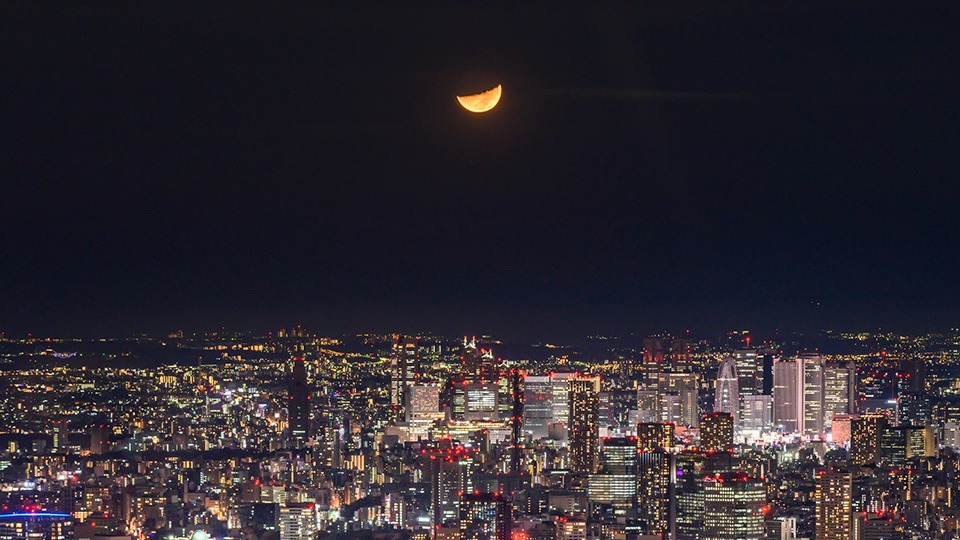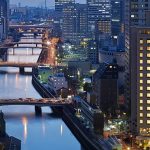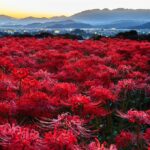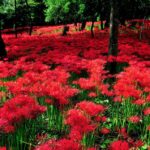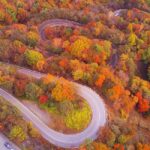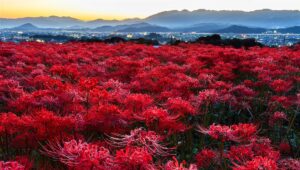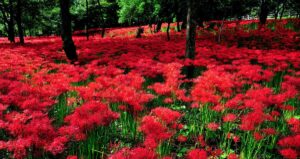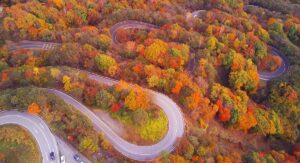Since ancient times, the Japanese have held a deep affection for the moon. From Heian-era nobles composing poetry in garden courtyards to Edo-period townspeople hosting moon-viewing gatherings along the riverside, moon gazing became a key custom for contemplation and for sensing the turn of the seasons. Today, during the Mid-Autumn Festival and on autumn nights, many places still host moon-viewing events in various forms, inviting visitors to relive the poetic elegance left by the ancients.
Across Japan there are many famous spots celebrated for their moonlit views—some known for striking natural scenery, some closely tied to history and culture, and others set against modern city skylines that create a fresh moon-viewing ambiance. Together, these places show the many faces of moonlight in Japanese culture.
This feature curates the “Top 10 Moon-Viewing Spots in Japan,” highlighting the most iconic locations where you can experience centuries of romance and poetry under the night sky.
Table of Contents
ToggleKatsurahama, Kochi Prefecture
Katsurahama has long been renowned as a premier moon-viewing site—its fame even appears in Kochi’s folk song “Yosakoi-bushi,” which sings of “Katsurahama, the famous place for moon viewing……”. Moonlight shimmering across the Pacific forms a majestic “Path of the Moon,” while the interplay of the bright moon and pine groves creates a timeless contrast of light and shadow.
Each year around the Harvest Moon, the “Katsurahama Moon-Viewing Festival” is held. The seaside walkway is lit with Japanese-style lanterns, and depending on the year there may be special programs such as nighttime hours at Katsurahama Aquarium, complimentary moon-viewing udon, and guided evening tours—activities beloved by visitors.
■ Address: 9 Urado, Kochi City
■ Hours: Open access
■ Admission: Free
■ OFFICIAL SITE
Matsushima, Miyagi Prefecture
As one of Japan’s “Three Scenic Views,” Matsushima has been praised for its moon since antiquity. In the Enpo era, the poet Matsuo Basho wrote of yearning for this place, likening the freshness of the Musashino moon to the scenery of Matsushima. For centuries, its luminous moon has charmed poets and aesthetes. Formed by some 260 islets, the dramatic seascape captures the hearts of night-scape lovers with a lyrical beauty, and it consistently ranks near the top in moon-viewing lists and polls.
With the changing seasons, Matsushima’s moonlight shows different moods, and it has long been regarded as a classic moon-viewing site. Even today, during the Mid-Autumn Festival, the historic Kanrantei—nicknamed the “Moon-Viewing Palace”—opens in the evening so guests can enjoy the moon in an elegant, old-world setting.
■ Address: Matsushima, Miyagi Prefecture
■ Hours: Open access
■ Admission: Free
■ OFFICIAL SITE
Shurijo Castle, Okinawa Prefecture
Set on a hill overlooking Naha, Shurijo Castle blends Chinese and Japanese architectural styles and served as the royal palace of the former Ryukyu Kingdom. Paired with the luminous moon, it creates a distinctive worldview and often ranks highly in night-scape nominations and polls. Okinawa’s ties with the moon run deep; some observers note that “the fusion of Ryukyuan and Chinese styles under the moonlight offers much to learn.” It is also Japan’s southernmost famed moon-viewing spot.
■ Address: 1-2 Shurikinjo-cho, Naha City, Okinawa
■ Hours: 8:00–20:30 (varies by season)
■ Admission: Adults ¥400, High school ¥300, Elementary/Junior High ¥160
■ OFFICIAL SITE
Moon Road Terrace, Shizuoka Prefecture
Izu-Kitagawa in Shizuoka is a small fishing-port hot-spring area of about 300 residents facing Izu Oshima. Its signature sights are the magnificent “moonrise” as the full moon lifts from the horizon, and the “Moon Road” as moonlight stretches across the sea. The community has turned this mystical scenery into a tourism asset, launching unique initiatives including the CD “MOON ROAD” (zampoña and quena) produced by musician Takamasa Segi, the “Thank-the-Moon Festival,” and a local confection called “Wish Sweets” inspired by the belief that “10 seconds of wishing on the Moon Road will make your wish come true.” In 2016, residents joined forces to build the “Moon Road Terrace (ムーンロードテラス),” now a superb spot to relax and enjoy the full moon.
■ Address: Kitagawa Onsen, Higashiizu, Shizuoka Prefecture
■ Hours: Open access
■ Admission: Free
■ OFFICIAL SITE
Enoshima, Kanagawa Prefecture
Depicted in ukiyo-e woodblock prints, Enoshima has long been a famous moon-viewing spot. On clear nights, you can even catch the iconic sight of Mt. Fuji framed together with the luminous moon. From the Enoshima Sea Candle Observatory—registered as part of the “Japan Night View Heritage”—you can take in sweeping views of the curved coastline, city lights, and the rising moon, all blending into a scene like a painting. In winter, Enoshima also hosts “Shonan no Hōseki (Shonan’s Jewel),” one of the Kanto region’s top three illumination festivals, also recognized as a “Lighting Nightscape Heritage.” Its harmony with the moon is highly praised by nightscape experts, often placing Enoshima at the top of rankings.
Enoshima Observatory
■ Address: 2-3-28 Enoshima, Fujisawa City
■ Hours: 9:00–20:00 (last entry 19:30). Extended hours during events.
■ Admission: Adults ¥500, Children (elementary school) ¥250
■ OFFICIAL SITE
Hashigui-iwa Rocks, Wakayama Prefecture
Located in Kushimoto, Wakayama Prefecture, Hashigui-iwa is a spectacular cluster of oddly shaped rocks designated as a natural monument. Stretching about 850 meters across the sea between Kushimoto and Oshima, roughly 40 rock pillars stand in a striking straight line. These formations originated about 15 million years ago when rising magma intruded into the Kumano strata and solidified as quartz porphyry dikes. From a distance, the rocks resemble bridge piers rising from the sea, hence the name “Hashigui” (bridge pillars). When paired with a bright full moon, the scene is one-of-a-kind, evoking the mysteries of nature. Weathered by centuries of waves, the remaining resilient pillars glow under moonlight, telling a story of time and grandeur. Each November, a light-up event illuminates about 25 of the rocks, creating a dreamlike atmosphere. This has been recognized as part of the “Japan Night View Heritage (Light-Up Heritage),” drawing many visitors during the season.
■ Address: Kushimoto Town, Higashimuro District, Wakayama Prefecture
■ Hours: Open access
■ Admission: Free
■ OFFICIAL SITE
Osanbashi Pier, Yokohama, Kanagawa Prefecture
This is Japan’s largest international passenger ship terminal. With a 360-degree panoramic view of Yokohama Harbor, Osanbashi is also listed among the “Japan Night View Heritage.” From here, you can admire Yokohama’s classic nightscape: the Landmark Tower, Red Brick Warehouse, and Cosmo World Ferris Wheel. The pier’s far end offers a prime view of the Yokohama Bay Bridge. For moonlit nights, the side facing the Bay Bridge is especially recommended—where the illuminated bridge and the shimmering “Path of the Moon” on the water combine for a breathtaking scene. Compared to the busy cityscape, this location offers a more serene, contemplative moonlit experience. Depending on the angle, visitors can enjoy various unique combinations of nightscape and moon. From November to March, the rooftop plaza is adorned with lights, blending beautifully with the moonlight to create a dreamlike atmosphere.
■ Address: 1-1-4 Kaigan-dori, Naka Ward, Yokohama City, Kanagawa Prefecture
■ Hours: Rooftop plaza open 24 hours
■ Admission: Free (rooftop plaza)
■ OFFICIAL SITE
Chikugo River Lift Bridge, Fukuoka Prefecture
This movable railway bridge was built in 1935 along the former Saga Line of Japan National Railways, spanning the Chikugo River to connect Okawa City in Fukuoka with Morodomi (now part of Saga City) in Saga Prefecture. After the line was discontinued, the bridge was preserved and converted into a pedestrian walkway, now called the Chikugo River Lift Bridge, designated as an Important Cultural Property and Mechanical Heritage. Each evening from sunset to 10:00 p.m., the bridge is illuminated. At high tide, the lights reflecting on the river create a dreamlike spectacle. The silhouette of the bridge against the moonlit sky seems to honor the brilliance of past engineering. Walking to the middle of the bridge, visitors can admire both the striking red steel framework and the bright full moon overhead. Whether viewed from the riverbank or experienced up close, the scenery is captivating.
■ Address: 614-6 Obo, Okawa City, Fukuoka Prefecture
■ Hours: Walkway open March–Nov: 9:00–21:00; Dec–Feb: 9:00–17:00
■ Admission: Free
■ OFFICIAL SITE
Iga City, Mie Prefecture
Known as the “City of Ninja,” Iga hosts unique events for the Mid-Autumn Festival throughout the city. The Iga Railway runs a special “Moon-Viewing Train,” dimming the lights in the cars while violin performances and conductor solos present moon-themed music. In the Ueno district, the “Ueno Castle Noh by Firelight” allows audiences to enjoy classical Noh theater under the glow of the moon and torches. In the Aoyama district, Omura Shrine holds its annual “Jugoya Festival.” Iga is also the hometown of the haiku master Matsuo Basho, who loved moon-viewing and left many verses about the moon. It is said that when he returned to his hometown, he even designed moon-viewing banquet menus to entertain his guests. Today, visitors can see his haiku monuments near Iga-Ueno Station and at the old city hall. With its rich cultural background and variety of events, Iga City offers a deeply poetic moon-viewing experience.
■ Address: Iga City, Mie Prefecture
■ Hours: Varies by event
■ Admission: Varies by event
■ OFFICIAL SITE
Tokyo Skytree, Tokyo
The Tokyo Skytree is Japan’s tallest observation landmark, with the Tembo Deck at 350 meters and the Tembo Galleria at 450 meters. In 2016, it was recognized as part of the “Japan Night View Heritage,” praised for redefining the value of nightscape appreciation. That same year, the Tembo Deck introduced a new program at the “SKYTREE ROUND THEATER®,” featuring moon-themed visuals combined with the city’s night view and moonlight, an innovation that won great acclaim. Since receiving its nightscape heritage designation, Tokyo Skytree has continued to host moon-related events and promote lunar culture. From here, visitors can gaze at the brilliant moon set against the panoramic skyline of Tokyo, creating a unique and unforgettable moon-viewing moment.
■ Address: 1-1-2 Oshiage, Sumida-ku, Tokyo
■ Hours: 10:00–21:00 (last entry 20:00)
■ Admission: Adults from ¥2,100, Middle/High school from ¥1,400, Elementary school from ¥850
※ Prices vary by date and type (advance, weekday, weekend). See here for details.
■ OFFICIAL SITE
Whether it’s the shimmering “Path of the Moon” across the sea, moon festivals carried on since the Edo period, or the bright moon viewed from a modern urban tower, Japan’s moon-viewing spots each offer their own distinct charm. These places not only showcase the beauty of nature and architecture but also let us reconnect with the timeless emotions the Japanese have held for the moon. Depending on where you stand, the moon may feel solemn, romantic, or steeped in history.
No matter where you are, when you look up at the night sky, perhaps you too will feel the same stirring of the heart as people did centuries ago. May this “beauty under the moon” become one of the most unforgettable sights of your journey.

